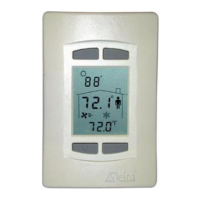DNS-24, DNT-T103 & DNT-T221 Application Guide
Page 22 of 43 Document Edition 4.2
Outputs 1 and 2 configured as a Tri-State pair require that the “Tri-State Runtime” (AV24) be
configured for the associated Tri-State actuator. The default of 120 seconds is suitable for certain
Honeywell actuators.
NOTE: Although “MUXing” is possible, it is not recommended because it can cause excessive
network traffic. DNT’s that are connected to a BACnet MS/TP network are designed to
operate as stand-alone devices using a local control application.
2. VAV – [Application (AV12) = 1]
Function: Control of a simple VAV box with air flow measured with a Kavlico sensor (DFT740-A) or
Setra sensor on Input 2 (0 to 1” range), a Tri-State damper on Outputs 1 and 2 (for DNT-T103) or an
analog damper on Output 1 (for DNT-T221), and various options on the remaining outputs (some no
longer available in Release 3).
DNT-T103 I/O (Outputs 1 to 3 are Triacs)
Tri-State Flow
Damper (Open)
Tri-State Flow
Damper (Close)
Tri-State Flow
Damper (Open)
Tri-State Flow
Damper (Close)
Tri-State Flow
Damper (Open)
Tri-State Flow
Damper (Close)
DNT-T221 I/O (Outputs 1 & 2 are Analog, and Output 3 is a Triac)
NOTES: For fan-powered boxes, series fans should always be configured for continuous
operation – never intermittent or the fan could run backwards on startup. When a parallel
fan is used in a heating application it should be configured as the 1st stage of heating (and
wired to the appropriate output accordingly), rather than as a fan output.

